Congratulations to the Winners of the 2017 Kick-Starts!
3D Modeling an Abdominal Aortic Aneurysm
Matthew Remy, Tyler Harken, Emily Solsrud, and Kat Tillman
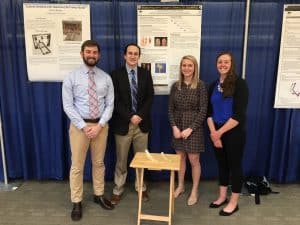 Our goal is to construct an anatomically accurate model of an abdominal aortic aneurysm (AAA) as well as the surrounding vascular anatomy, more specifically the iliac arteries where surgeons access the aneurysm from. We have come to the conclusion that the way to make this most accurately and most repeatable would be using 3D printing technology. Our end goal is to develop a procedure in which a CT scan of an aneurysm could be developed into a workable model within 24 hours, so the surgeon could practice on patient-specific anatomy prior to undergoing surgery. Our end goal is to provide the hospital with roughly ten different 3D printed AAA models with iliac arteries that have different anatomy to help surgeons master these challenging aspects.
Our goal is to construct an anatomically accurate model of an abdominal aortic aneurysm (AAA) as well as the surrounding vascular anatomy, more specifically the iliac arteries where surgeons access the aneurysm from. We have come to the conclusion that the way to make this most accurately and most repeatable would be using 3D printing technology. Our end goal is to develop a procedure in which a CT scan of an aneurysm could be developed into a workable model within 24 hours, so the surgeon could practice on patient-specific anatomy prior to undergoing surgery. Our end goal is to provide the hospital with roughly ten different 3D printed AAA models with iliac arteries that have different anatomy to help surgeons master these challenging aspects.
Sponsor: M.L. (Suresh) Raghavan
Autonomous Robotic Boat
Abdualrahman Ismail, Mike Watkins, Brian Van Arb, Kathryn Klarich, Grace Edwards, and Tomas Eismann
The goal of the Iowa Marine Autonomous Racing Club (IMARC) is to design and build an autonomous, robotic boat to navigate and race through an aquatic obstacle course. The task of my sub-group is to design and build the hull and propulsion system for the boat. We plan to design the shape of the hull for speed and maneuverability. However, this is easier said than done. It is simple to make a fast boat, but then it would lack maneuverability and vice versa. The boat must be able to navigate through pairs of buoys, avoid obstacles, detect underwater devices, return to dock and do other miscellaneous tasks as fast as possible. Specifically, we would like to use funding from the Creative Kickstart Grant to design and build a steering system for the boat. This will involve setting up stepper motors controlled by motor controllers to move the main motor shaft. This project will provide opportunities to aid in the formal training and education of students in unmanned vehicle systems technology and give those students practical experience in this growing field.
Sponsor: James Buchholz
The Bandit
Sy Butler, Daniel Kelly, and Liam Hagan
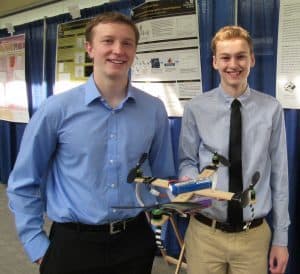 Our idea is to make a custom, built-from-scratch quadcopter drone called The Bandit. Using a combination of 3D printing technology and parts found online, plus our own code, we will be able to create a functioning drone for much cheaper than the market equivalent and will have fully customizable hardware and software components. Once complete, the Bandit will serve as proof of concept of a drone kit: a group of parts that others can purchase and assemble into their own drone with ease. Using similar parts and methods, anyone can follow our lead to create their very own quadcopter. We can provide our software to make it even easier. By uploading to sharing websites, we will enable others to use the code we’ve written as source code, allowing their drone to fly without doing any programming of their own. Additionally, they will be able to customize our easily accessible code to tailor it to their own specifications.
Our idea is to make a custom, built-from-scratch quadcopter drone called The Bandit. Using a combination of 3D printing technology and parts found online, plus our own code, we will be able to create a functioning drone for much cheaper than the market equivalent and will have fully customizable hardware and software components. Once complete, the Bandit will serve as proof of concept of a drone kit: a group of parts that others can purchase and assemble into their own drone with ease. Using similar parts and methods, anyone can follow our lead to create their very own quadcopter. We can provide our software to make it even easier. By uploading to sharing websites, we will enable others to use the code we’ve written as source code, allowing their drone to fly without doing any programming of their own. Additionally, they will be able to customize our easily accessible code to tailor it to their own specifications.
Sponsor: Gary Christensen
Desktop CNC Router/3d Printer Hybrid
David Regan
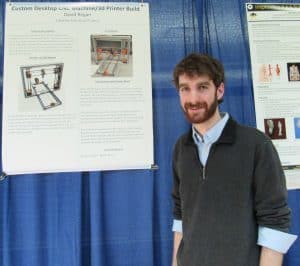
I am currently in the process of designing an Arduino controlled desktop CNC machine. If I receive this funding, I would like to alter the design in such a way to make the machine modular so that it can quickly be switched between a CNC router, and a 3d printer. I’m interested in this idea because it will hopefully give me hands on experience in design, fabrication, and the operation of CNC equipment. Though this project is not meant to directly solve a problem, it allows for the fabrication of future engineering projects. I hope for it to be a self contained compact solution for creating parts from home.
Sponsor: Matias Perret
Electronic Buccal Drug Delivery System
Kasra Zarei
Prolonged drug treatment is critical for patients with a range of medical conditions. A proof-of-concept buccal (i.e. cheek) drug delivery device has already been developed. However, there are considerable opportunities for advanced buccal devices, particularly those involving electronic components. An enhanced Buccal Drug Deli
very System has far-reaching applications due to the ability to provide safe controlled release of drugs (eugenol, chlorhexidine, etc.) over prolonged periods of time such as in sleep. Such a device, even without electronic components, has the ability to function is a stent for the mouth that can help patients with sleep apnea by allowing increased entry of oxygen.
Sponsor: Max Baker
Gripping Neuropathy
Jimmy Moore, Bailey Hawn, and Alec Monaghan
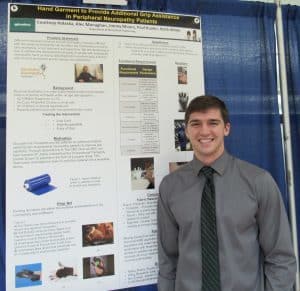
One characteristic seen in individuals with neuromuscular disorders is joint and movement problems. Patients who develop atrophy or exhibit fine-grained motor control problems suffer from simple tasks such as holding or picking up objects. There is a need for products that provide the additional strength and friction needed to hold and pick up objects. The proposed idea entails creating a garment for the hand to assist patients and individuals with their daily motor needs, as an excellent compromise between low cost and durability.
Sponsor: Sarah Vigmostad
The Little Jonny That Could: Providing Independence for Congenital Arm Amputees
Alicia Truka, Kylie Hershberger, Mitchell Miller, and Nathaniel Witt
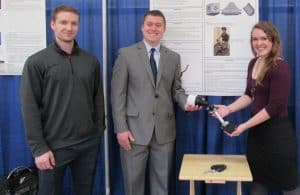
We are aiming to create a device that will assist developing children, ages 5-10, who are single arm amputees above the elbow maintain control of the handles while operating their bicycles in order to let them ride independently. We are currently working with a seven year old boy who has difficultly riding his bike due to his missing limb and wants to gain the independence to ride his bike without training wheels.
Sponsor: Nicole Grosland
Precision Landing System for Autonomous Aircraft
Michael Watkins
Goal: Land a fixed wing unmanned aircraft on a standard sized (4’x8’) sheet of plywood to learn about aeronautical engineering and electronics principles.
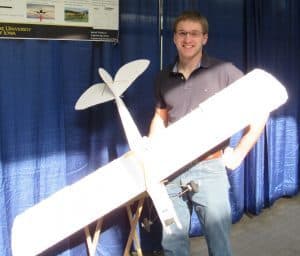
Means: Use a ground based infrared radiation emitter and aircraft mounted receiver to act as a guidance system for the aircraft. The system will roughly replicate the Instrument Landing System (ILS) used at airports all over the world, which is used to guide the aircraft to safe landings, even in low visibility conditions. See Figure 1, below. The unmanned aircraft based system will use a PixHawk autopilot for navigation and flight stabilization. An Arduino board will be used to process and relay data to the PixHawk from an IR-sensitive eye. This aircraft based system will be used in concert with the ground based emitter system to guide the aircraft towards the desired landing area. The ground based emitter system will create a cone of solid light in the region that represents an appropriate glide path for the aircraft. In regions left, right, above and below the appropriate glide path, light at different frequencies will be emitted to signal the aircraft to modify its course back toward the appropriate glide path. The initial aircraft used will be made from foam board. The second aircraft, which will be used for more thorough testing of the system will consist of a carbon fiber or aluminum keel tube, foam wings, and 3D printed ribs, horizontal tail and vertical tail surfaces.
Sponsor: Matias Perret
Smart Mirror
Liam Hagan, Sy Butler, Daniel Kelly, and Zane Johnson
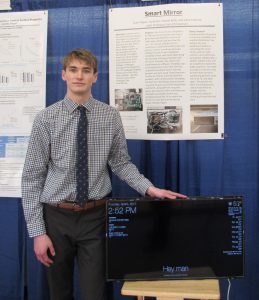 My team wants to build a smart mirror. This would be a mirror that could display the time, date, weather, calendar, and other useful information. The goal of a device like this is to put all the important information about one’s day on a surface that people already spend time looking at every day. A smart mirror has the potential to increase efficiency in the morning, as the time spent in front of a mirror would then also be used to gather important information needed to start the day. The device works by laying a two-way mirror on a monitor screen powered by an extremely compact computer, the Raspberry Pi 3. The two-way mirror allows for the light from the monitor to shine through, which allows text and images to be seen through the mirror. The Raspberry Pi would take information from a custom website containing the data for the time, date, weather, etc. and display it on the monitor.
My team wants to build a smart mirror. This would be a mirror that could display the time, date, weather, calendar, and other useful information. The goal of a device like this is to put all the important information about one’s day on a surface that people already spend time looking at every day. A smart mirror has the potential to increase efficiency in the morning, as the time spent in front of a mirror would then also be used to gather important information needed to start the day. The device works by laying a two-way mirror on a monitor screen powered by an extremely compact computer, the Raspberry Pi 3. The two-way mirror allows for the light from the monitor to shine through, which allows text and images to be seen through the mirror. The Raspberry Pi would take information from a custom website containing the data for the time, date, weather, etc. and display it on the monitor.
Sponsor: Gary Christensen
T4 – Table Top Tension Tester
Brett Austin and Srivats Sarathy
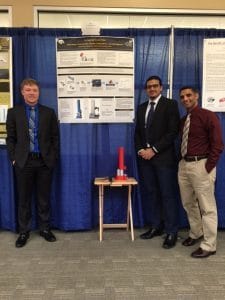 Our idea is to build and open-source uniaxial extension tester utilizing 3D-printing, micro-controllers, stepper-motors and load sensors. Many of the cardiovascular diseases that we suffer from are the result of soft tissue material failure. Understanding the material properties of biological soft tissues helps in diagnosing the underlying cause of failure and can lead to the development of artificial bio-prosthetic devices that better mimic biological tissues.
Our idea is to build and open-source uniaxial extension tester utilizing 3D-printing, micro-controllers, stepper-motors and load sensors. Many of the cardiovascular diseases that we suffer from are the result of soft tissue material failure. Understanding the material properties of biological soft tissues helps in diagnosing the underlying cause of failure and can lead to the development of artificial bio-prosthetic devices that better mimic biological tissues.
We plan on developing a device that can perform uniaxial extension for various biological soft tissues and offer flexibility to the end-user. The use of an Arduino micro-controller with stepper motors and load sensors will help us execute and analyze material properties of soft tissues.
Sponsor: M.L. (Suresh) Raghavan
